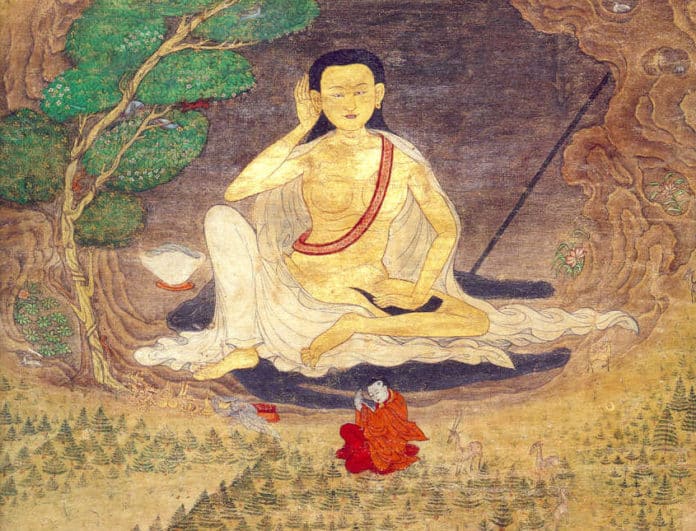
This song focuses on Rechungpa’s relationship with Milarepa. Milarepa had decided to keep on moving, without stopping to meet with some patrons. Rechungpa was not happy about this, but nevertheless he kept going. When they arrived at their camp, Milarepa sent Rechungpa to get some water while he made a fire. While Rechungpa was gone, he became entranced by the beautiful wild asses in the region—and Milarepa took the opportunity to burn all the books Rechungpa had brought back with him from India. When Rechungpa realized what was happening, he became completely freaked out and hostile. Milarepa proceeded to show Rechungpa a series of magical displays, but Rechungpa kept obsessing about his books. However, when Milarepa threatened to fly away completely, Rechungpa became heartbroken, suicidal, and filled with remorse. He realized that, without his guru, all his books were useless.
Rechungpa’s Encounter with the Wild Asses

Along with “The Story of the Yak Horn,” we discussed how Rechungpa’s earlier relationship with his guru and his reactions to Milarepa were very much involved with basic ego and with confirming Rechungpa’s expectations. He actually expected that his teacher, Milarepa, would submit to his pride. After the miracle of the yak horn, the next story also seems to be very interesting and significant.
This story talks about wild asses, which are called kyang in Tibetan, and resemble mules. This particular highland mountain animal is quite rare in other countries. In Tibet it is regarded as a Mongolian wild ass. The analogy of wild asses plays quite a dominant part in the story. The kyang in this case represents the seductive qualities of the dakinis, or the dakini energy principle. When the seductive qualities of dakinis manifested in this particular story, it seemed to be the start of an evolutionary process of Rechungpa’s development of doubts as well as of spirituality. It was the start of Rechungpa’s regaining his faith in his guru.
A wild ass was one of the central attractions for Rechungpa when he went down to collect water. It is said that he saw one of the ringleaders of the kyang transform into a jackal, and that jackal seemed to chase away the other kyang. That is obviously the transformation of the seductive quality of kyang into the aggressive aspect of the dakini energy principle. It could be said to be the protective divinity principle.
Protective divinities, or protectors of the dharma, play a great and important role in the vajrayana teachings generally. When we talk of a protective divinity, it is not just a spirit guarding the doctrine or teaching, like a jealous ghost or god, but it is the energy of a watchful eye, as well as a more general kind of energy. The protective divinity is associated with the union of energy and skillful means. Energy united with skillful means is like a watchful eye. This watchful eye never misses any wrong actions or wrong situations, and it also sees whatever needs to be protected. Whenever you need any kind of destroying action, it destroys, and simultaneously, whenever there is any action you wish to protect, it protects.
In the meditation state, or the practice of meditation, the watchful eye of the protective divinity could be regarded as awareness—a sudden glimpse of awareness. Such a glimpse need not be a deliberate effort. That is, when a person is in the right state of understanding in the meditative state, that person does not deliberately and consciously have to develop awareness, but unconsciously, the awareness comes to that person suddenly, as a reminder.
Many people have this experience. When they are in the midst of situations, very much in the play of life, suddenly there is a glimpse, a sudden realization. Confirmations of the guru’s words, or certain phrases from scripture, or certain experiences that are very meaningful suddenly crop up. They suddenly just appear. Since the teachings of the dakinis need very much to be protected, to be completely unadulterated and pure, there is the protective divinity aspect, a sudden, spontaneous flash.
The display of wild asses created enough time for Milarepa to open Rechungpa’s packed baggage, put his books into the fire, and burn them. And interestingly, the text says that a lot of these books were books of logic or of magic. It does not say black magic, but simply texts of magic, and Rechungpa had a certain amount of fascination with both. Rechungpa identified himself with the establishment of Milarepa’s followers. He wanted to set up a church, so to speak, or an organization that would have enough knowledge to defend itself from attacks coming from outside or from different sects and schools. In this, of course, his fascination with magic played an important part. These doctrines did not need to be black magic; they could just be magic in the sense of conjuring tricks using a great deal of mantras, yantras, diagrams, and other forms.
So Rechungpa represented the ambition of setting up an establishment, and Milarepa represented the creator or originator. Milarepa was not concerned with the followers of this church or with the directions of the religious establishment: he was purely interested in the presentation of the dharma to people. And Milarepa’s miraculous displays, as we discussed before, were connected with the meeting of two minds. As much as Rechungpa had tremendous doubt and anger, as much he had developed rage against Milarepa, he still had a tremendous link with Milarepa, so he was able to see Milarepa’s displays of miracles.
Milarepa’s Display of the Mandala of Divinities
In one of Milarepa’s displays of miracles, he demonstrated the mandalas of the various tantric divinities on his various centers or chakras: on his secret center, navel center, heart center, throat center, forehead, and the top of his head. He sang,
Listen again, my son Rechungpa.
The body of the guru is the mandala or dwelling place of the dakinis.
In this body there dwell hundreds of mandalas.
Working with the Chakras
Before going further with this story, it might be helpful to say something about the Buddhist understanding of chakras. Fundamentally, there need not be chakras at all. But because the complication of samsara has started, nirvana has to begin as well. That is the starting point of everything, of all this symbolism.
The chakras serve as the neurotic centers of mind. When teachings refer to the ultimate chakras unfolding in the practice of meditation, it means that you are working on these particular neurotic aspects of mind. For instance, the heart chakra is associated with ignorance. So you work with your ignorance, and when you transcend ignorance, it becomes space and openness. So this seems to be a complementary process, in such a way that you get personal feelings or effects from working on those chakras—very much so.
In one Buddhist chakra system, at the tip of one’s foot there is a chakra, and another chakra at the knee. However, in the general Buddhist chakra system, the avadhuti, or central nadi, extends from about four fingers beneath the navel to the secret chakra, and the two main nadis, lalana and rasana, join there. So the secret chakra is regarded as the ultimate chakra. In this chakra, all the chakra activities could end and all the chakras activities could develop, which is the same principle as the charnel ground. This chakra is regarded as the creative or mother principle. The secret chakra is connected with water, which is associated with passion, as well as with joy and creation. So meditating on the secret chakra is regarded as quite dangerous. You are playing with energy and with all sorts of sexual impulsive thoughts. If a person has not learned to work with the secret chakra, there could be an unexpected flow of desires and passions, but if they are able to work with it, then this passionate desire could be transformed into everlasting joy and bliss.
By practicing meditation on certain centers of the body, one does get a kind of purified experience, so to speak, a certain amount of joy and a feeling of space. In terms of speech, there might be feeling that you would like to talk a lot or compose poems. The throat chakra and head chakra are connected with physical health. You feel invincible and tough and healthy. You get these kinds of experiences because such meditation is an undoing of the neurotic centers of the body. You get actual personal feelings from it.
The naval chakra is connected with earth and solidity as well as with wealth. The neurotic aspect is one of centralizing in oneself, the ego principle. You feel that you want to be saved completely. You want to be static and not get involved. The fundamental principle of pride is unwillingness, not being willing to surrender. In fact, a lot of people have difficulties when they change from their meditation on the secret center to the navel chakra. They are very reluctant to go ahead. That kind of psychological aspect comes into one’s mind. So working with the chakras seems to be an evolutionary process, a continual loosening-up process. Of course, a person does not have to actually visualize the chakras, but purely by meditating, one would experience the potential of the chakras within oneself without consciously, technically working on the chakras as such.
Milarepa’s Chakra Display
Milarepa went on to say that in his secret center was the mandala of Chatupitha (Tib. Dorje Denshi). He said that this mandala is connected with water and passion, and with the development of kundalini and chandali. And he told Rechungpa that it is the radiation of this mandala that develops perfect joy.
Milarepa said that in his navel center was the Chakrasamvara (Tib. Demchok) mandala with sixty-two divinities. Chakrasamvara is connected with mother tantra and with the creation of all the mandalas and divinities. The navel chakra, or all-manifesting center (Skt. nirmana-chakra), is connected with earth and with multiplying or the manifestation of female tantra. The navel chakra is associated with body, with earth, and therefore with the indestructible vajra family.
In terms of the heart center of the dharmachakra, Milarepa talked of the Hevajra mandala and Hevajra tantra. The heart center is associated with space, and therefore with the manifestation of space through symbolic images. In the heart-center chakra, there is a mandala with nine divinities, which are a manifestation of the three sattvas, or “beings.” The samayasattva is the deity visualized by the practitioner. The wisdom sattva, or jnanasattva, is connected with the transcendental aspect or nondualistic state. The meditation sattva, or samadhisattva, is associated with a completely restful state of mind, which creates the various divinities. The creation of divinities refers not only to external divinities but also to the different aspects of the energy of one’s state of mind. The heart center is also called the vajra heart center, or indestructible heart center.
In the throat center (Skt. sambhoga-chakra) there was the Mahamaya mandala. The mandala of this divinity is associated with the illusory aspect of life, of both samsara and nirvana. Maya means “mirage” or “illusion,” and maha means “great,” so Mahamaya means “great illusion,” or the creation of great illusion. This center is associated with vajra speech and with fire. It is connected with the consuming and burning quality of the illusory body, and with the illusion aspect, which perpetually develops things without trying to control them.
In the forehead, or white conch, chakra dwells Buddha-Kapala (Tib. Sanggye Thöpa). This chakra is associated with the insight or precision of wisdom. The precise quality of wisdom is connected with the buddha family of the central mandala of space. It is associated with the Vairochana principle at the center of the mandala, and with the all-pervading or all-conquering aspect of all the other centers.
At the top of the head is the mandala of great joy (Skt. mahasukha-chakra): the mandala of Guhyasamaja (Tib. Sangwa Düpa). This is connected with the father tantra, which presents the nondualistic thinking of bindu and nadi.
Milarepa’s demonstration of the different chakras in the body is associated with the different orders of tantra: Chakrasamvara and mother tantra, Hevajra and father tantra, Guhyasamaja and father tantra, and Kalachakra and nondual or union tantra. These different aspects or orders of tantra represent different aspects of the continuity in one’s state of being. In other words, each one is connected with a different aspect of energy: the feminine principle of energy, the masculine principle of energy, the union principle of energy, and the transcending principle of energy.
In anuttara tantra, Kalachakra tantra is the ultimate energy of transcending all these energies into oneness. In other words, it transcends the union aspect as well. In the word Kalachakra, kala means “time,” and chakra means “wheel.” So the ultimate chakra, Kalachakra, symbolizes the aspect of transcending time. In other words, it symbolizes the fourth moment, which is transcending nowness. In dualistic thinking, you try to dwell in the nowness; you try to stick to that particular conceptualized meditation. When you transcend that clinging onto nowness, you have the experience of reaching the fourth moment, which is greatly emphasized, particularly in the mahamudra teaching.
The principle of transcending goes on and on and on; it is endless, actually. But in the teachings, when the term fourth moment is used, it literally means transcending nowness. That is, nowness could be just a convenient step to use as a kind of resting place or dwelling place. Rather than being able to perceive and to be open thoroughly and fully, you remain in a state of nowness. Nowness can become used too much as a principle, as an idea, and then it becomes overused so that it has no meaning anymore. It can become a way of escaping. There is something to dwell on: on that moment. One feels safe and sound, because one has already realized that the past is not valid and the future is not valid; therefore, something is valid at this very moment. You try to hold on tight, to cling to that. It becomes almost like concentrating the past and future into nowness, which has clinging going on. Transcending that clinging process is the fourth moment, where you are completely destroyed. All the seats you have prepared that you can sit on have been completely taken away, and there is no resting place left. Every possible kind of unexposed corner has been lighted up.
Cutting Through Rechungpa’s Pride and Doubts
In terms of Rechungpa’s experience of doubts, it seems that it was a continual process. First, Milarepa had to show a miraculous display of pure symbolism, an artistic display like an eight-petaled lotus and all sorts of aspects of the symbolic method. Then Milarepa went on to the next method, a display of the mandalas. Then all these mandalas and conceptualized ideas were drawn back into the guru principle, as Milarepa multiplied himself into three Milarepas.
Lastly, to actually and finally shock Rechungpa, Milarepa said that he was going to step out into the realm of the dakinis. That seems to have been the moment when Rechungpa actually decided to give up his pride and his possessiveness of books and everything, which shows that at that moment
Rechungpa had not yet transcended to an understanding of the guru as the cosmic guru principle,* rather than the personal living guru. Milarepa’s threat brought him down very much, because he was suddenly reminded of his security and safety and of the father figure he was beginning to lose.
It seems very ironic how suddenly Rechungpa reacted, considering his song at the beginning, where he talked of all that he had accomplished, how he had received so many teachings and learned a great deal. If you compare that song with this particular experience, it would seem as if he would not have reacted to his guru’s display in this way. Earlier, Rechungpa had thought to himself that perhaps he should go back to Tipupa in India and just abandon Milarepa. He thought that, if he threatened to abandon Milarepa, then perhaps Milarepa would like to communicate with him. By means of such threats Rechungpa had been trying to possess his teacher. That was his basic wish or desire.
Rechungpa had been tremendously excited about being able to receive such teachings, managing to translate these texts into the Tibetan language, and being able to bring back the doctrine. He had helped Milarepa so much that he would have liked to receive some kind of reward for his service. But he did not receive any reward, which was very wise of Milarepa. From Milarepa’s point of view, if Rechungpa had received a reward, it would have been more encouraging to his ego. At the beginning, in sending him to India, there had been encouragement of Rechungpa’s ego. So, if Milarepa were to congratulate him and give him a reward, that would be double encouragement. It would multiply the health of the ego, which would be very dangerous. So Milarepa’s approach at this moment was precisely the kind of treatment needed to break down the emotional development of Rechungpa’s relationship to him. It was necessary to bring that down, which was a very beautiful and skillful action. And in this case, Rechungpa was able to communicate thoroughly and properly that he had not lost ultimate faith in Milarepa. He had not actually broken away from it.
Milarepa’s Song of View, Practice, Action, and Result
In his final song, Milarepa said that the view is the wisdom of knowing emptiness; the meditation is nonclinging, or luminosity; the action is continued dispassionateness, or nonattachment; the result is immaculate nakedness. He then went on to interpret this.
View: Emptiness
Milarepa said that the view of emptiness wisdom is in danger of becoming a verbalized view or a fascination with particular philosophical ideas and concepts. Such conceptualized ideas and philosophical thinking are very much connected with an intellectual way of thinking and logic, which automatically creates a tremendous veil or cloud in one’s mind. By using words, one does not gain confidence in the ultimate meaning, and it is impossible through concepts to gain freedom from ego clinging. Therefore, one has to work hard.
Practice: Experience of Nonclinging Luminosity
In terms of the experience of meditation being nonclinging luminosity, Milarepa said that there is the danger of trying to dwell on the stillness of mind. Therefore, he did not place a great deal of emphasis on meditation as a way of completely subduing your mind into one still, peaceful state. In fact, the oral tradition of meditation in Buddhism in general—and particularly in Milarepa’s Kagyü tradition of meditation—is that meditation is not at all regarded as just a way of resting oneself into one-pointedness. Meditation is the continual process or action of opening, rather than trying to still oneself down into one-pointedness.
Fundamentally, meditation is not trying to secure something or trying to make something static at all. It is trying to create more space or openness, so the stillness becomes a by-product. When you create more space, you begin to find a kind of quiet and peaceful atmosphere as well. For instance, if you remove very heavy furniture from your room, then it suddenly begins to feel a bit more spacious. It is still and open at the same time.
And quite rightly, Milarepa went on to say that, if wisdom has not shone from within, then dwelling in steadiness or stillness does not bring wisdom, and it does not bring freedom. He said that in that way you do not develop wisdom from wandering mind and dullness; therefore, you have to practice the awareness mind. When he said that one has to develop wisdom within wandering mind as well as dullness mind, he was saying that these very exciting and continual activities taking place in one’s mental state must be used as a part of the development of the meditation. So meditation does not become a way of trying to calm down your mind, but it is a continual working process. Therefore, one has to develop awareness, a sudden glimpse of awareness through the practice of recollection.
Action: Continuous Dispassionateness
In terms of action as continuous dispassionateness, Milarepa said that there is the danger of one’s actions becoming wild, neurotic indulgences. If one has gained a conceptualized or philosophical notion of the view, and one has also gained a conceptualized idea of meditation practice, then one’s actions could also become very neurotic. One could be living purely on ideas rather than on the experience of meditation. One’s actions become purely neurotic for the very fact that one is unable to keep to a steady, continuously open state of mind. So one’s openness turns into wildness. Milarepa said quite precisely here that, when view and meditation do not become friends with one other, one’s actions become companions to the eight worldly concerns. Therefore, one has to practice nonclinging, nonattachment, and transparency.
One’s action has to be transparent action. In other words, you do not just engage in heavy and meaningful action, as though you had learned something from a great teacher or from your experiences and you were trying to present that heavy stuff that you had learned already. If you demonstrate that in a very heavy way, your presentation might be able to impress a certain type of audience, but it does so purely by overwhelming them rather than by inspiring them, since the action was not transparent, not light, not seeing-through. In other words, whatever action you add for yourself or for your friends, that action must have a quality of intelligence. There is a need for continual communication so that action does not stand in the way of communication with others or with oneself.
One could see through with action. One could use action as a continual seeing-through process of transparent nature, which means that action and meditation and the philosophical view of emptiness have become one. When they have become friends, when you have learned to apply your philosophical intellectual view as feeling, and when that feeling becomes the meditative experience itself, then when you try to put that experience into practice, your action will become completely clear and precise, and not produce a solid ego.
Result: Absolute Nakedness
Then Milarepa talked about the result. He said that it was spotless, immaculate nakedness, but that there was a danger of clothing it with clinging. The Tibetan word tsenma, which means “mark” or possibly “label,” could be a very good word for this. There is a danger of labeling or clothing this spotlessness with a particular concept. That is to say, the result or ultimate achievement could become a label, an expected state of mind, and then one might try to achieve that particular state that had already been labeled.
The basic nature of this nakedness is the root or origin as well as the result. So, instead of just perceiving or realizing the naked state of mind as the result, one is admitting that it is the result, as well as the path, as well as the starting point. If we are trying to put heavy preconceived ideas onto it, there is a danger that the confusion will not disentangle within oneself. It is useless to meditate with a wish-fulfilling meditation, wishing that you might achieve your awakened state of buddha nature and a higher state of living in the future. Therefore, it is necessary to disentangle one’s confusion. That seems to be the last song of the wild ass chapter.
















